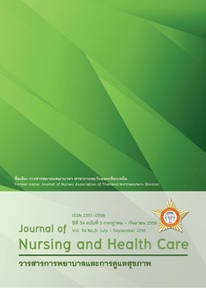ผลของโปรแกรมการพัฒนาต้นทุนชีวิตต่อการลดพฤติกรรมเสี่ยงทางเพศในวัยรุ่นตอนต้น Outcomes of Program’ Life Assets Development to Prevent Sexual Risk Behaviors Among Young Adolescence
คำสำคัญ:
ต้นทุนชีวิต วัยรุ่นตอนต้น พฤติกรรมเสี่ยงทางเพศ life assets, early adolescence, sexual risk behaviorsบทคัดย่อ
บทคัดย่อ
การวิจัยกึ่งทดลองนี้ มีวัตถุประสงค์เพื่อศึกษาผลของโปรแกรมการเพิ่มต้นทุนชีวิตต่อการลดพฤติกรรมเสี่ยงทางเพศ
ในวัยรุ่นตอนต้น เลือกแบบเจาะจงตามคุณสมบัติ 36 คน เป็นวัยรุ่นอายุระหว่าง 10-14 ปี ที่อาศัยในหมู่บ้านแห่งหนึ่งของตำบลดวนใหญ่ อำเภอวังหิน จังหวัดศรีสะเกษ แบบกลุ่มเดียววัดผลก่อนและหลังการทดลอง กลุ่มตัวอย่างได้รับโปรแกรมการพัฒนาตน้ ทุนชีวิตในวัยรุน่ ตอนตน้ เครื่องมือที่ใชร้ วบรวมขอ้ มูล ไดแ้ ก ่ แบบสอบถามขอ้ มูลทั่วไปของวัยรุน่ แบบสอบถามตน้ ทุนชีวิตเด็กและเยาวชน และแบบประเมินพฤติกรรมเสี่ยงทางเพศของวัยรุน่ วิเคราะหข์ อ้ มูลโดยใชวิ้ธีการแจกแจงความถี่ค่าร้อยละ ส่วนเบี่ยงเบนมาตรฐาน และสถิติทดสอบ paired t-test ศึกษาระหว่างเดือนมีนาคม พ.ศ. 2559 ถึง เดือนเมษายนพ.ศ. 2559 ผลการวิจัยพบวา่ กลุม่ ตัวอยา่ งที่เปน็ วัยรุน่ ตอนตน้ มีคา่ เฉลี่ยคะแนนตน้ ทุนชีวิตเด็กและเยาวชนสูงกวา่ กอ่ นการทดลองอย่างมีนัยสำคัญทางสถิติที่ระดับ 0.05 และค่าเฉลี่ยคะแนนพฤติกรรมเสี่ยงทางเพศของวัยรุ่นลดลงกว่าก่อนการทดลองอย่างมีนัยสำคัญทางสถิติที่ระดับ 0.05 จึงสรุปได้ว่า วัยรุ่นตอนต้นที่ได้รับโปรแกรมการพัฒนาต้นทุนชีวิตในวัยรุ่นตอนต้นมีพฤติกรรมเสี่ยงทางเพศที่ลดลง ดังนั้นโปรแกรมนี้จึงเป็นทางเลือกหนึ่งสำหรับพยาบาลในการลดพฤติกรรมเสี่ยงทางเพศของวัยรุ่นในชุมชน
Abstract
This quasi-experimental research aimed to study the effects of life assets improvement program on early adolescence. Subjects were selected using purposive sampling method and the 39 teenagers with 10-14 years old age stayed in the village at Thambon Duanyai, Amphur Whanghin, Sisaket Province. This study used the one group pretest posttest design. Instruments used for data collection included an individual memo file, Developmental
Assets Survey and the adolescence’ sexual risk behaviors assessment. The data were analyzed by descriptive data such as frequency, percentage, arithmetic mean, standard deviation and paired t-test. The research was conducted during March 2016 to April 2016.
The research exhibited that post-test result of the developmental assets survey had higher than pre-test of the developmental assets survey statistically significant at 0.05 and that post-test result of the adolescence’ sexual risk behaviors assessment had lower than pre-test of the adolescence’ sexual risk behaviors assessment statistically significant at 0.05.
In conclusion, early adolescence who received life assets improvement program on early adolescence had decreased sexual risk behaviors. Therefore, this program is provided for nurses to select for reducing sexual risk behaviors among early adolescence in the community.



